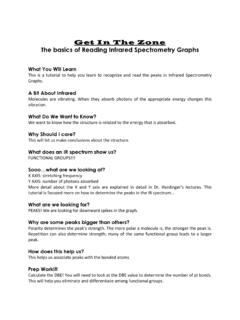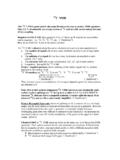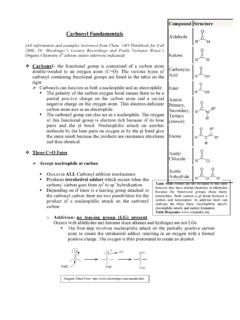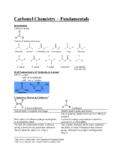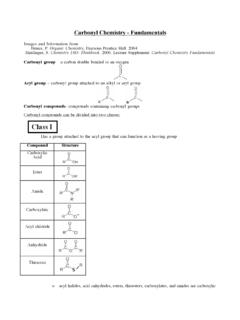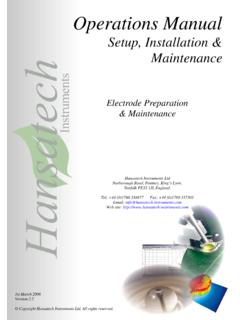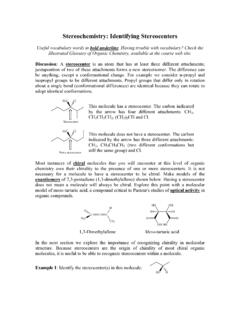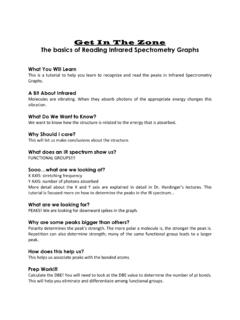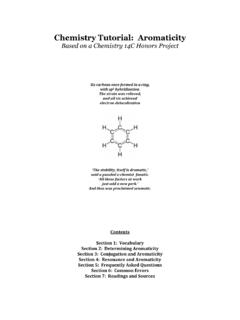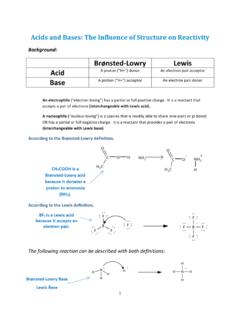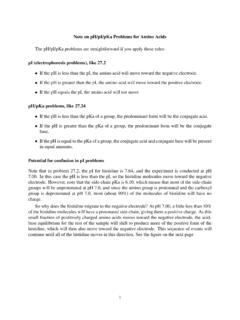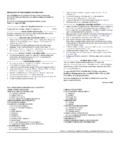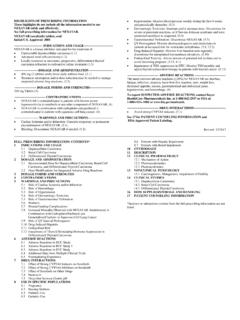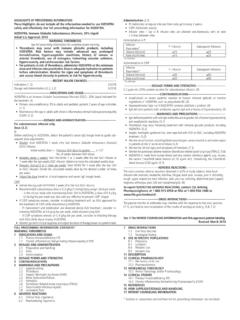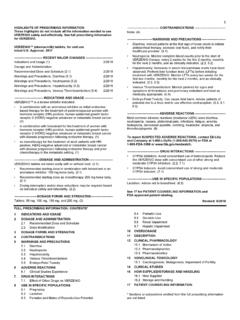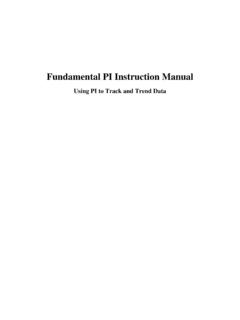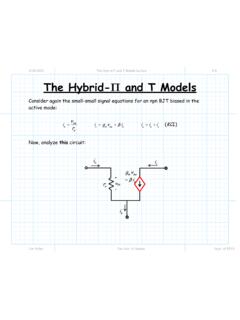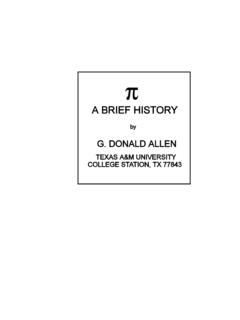Transcription of Counting Pi Electrons and Electrons Involved in Aromaticity
1 Counting Pi Electrons and Electrons Involved in Aromaticity How to find atoms with p orbitals: When looking at a molecule and deciding how many lone pairs are in p orbitals, it is first important to decide which atoms have p orbitals. The first thing to look for is to find atoms that are Involved in double or triple bonds. These atoms have to have p orbitals because the p orbital overlap is what is Involved in the pi bond. I have put arrows to these atoms in cytosine below: Next you have to look at other atoms that are not Involved in a pi bond and ask yourself whether that molecule would benefit if this atom had a p orbital. If the atom can become Involved in conjugation the answer is usually yes.
2 In the cytosine molecule above both the nitrogens with no double bond will benefit from having a p orbital because they will be able to be Involved in conjugation and maybe even Aromaticity which we will explore later. These nitrogens are pointed out below: How to decide which Electrons are in p orbitals: After you find all of the p orbitals, you need to decide which Electrons are in the p orbitals. Automatically you know that the Electrons Involved in double bonds are in the p orbitals. Next look at lone pairs. There are also lone pairs on the nitrogens and two lone pairs on the oxygen. We will have to decide which lone pairs are in sp2 orbitals and which are in p orbitals.
3 First let s look at the top nitrogen. It has three sigma bonds so you know that all three sp2 orbitals are Involved in sigma bonds. This leaves one p orbital for the lone pair to occupy. The same logic can be applied to the lowest nitrogen. The middle nitrogen has two sigma bonds and one pi bond. You know that one p orbital is used in the double bond and two sp2 orbitals are Involved in the sigma bond. This leaves one sp2 orbital for the lone pair to occupy. The oxygen is Involved in one pi bond and one sigma bonds. You know that the p orbital is Involved in the pi bond and one sp2 orbital is Involved in the sigma bond. This leaves two sp2 orbitals for the lone pairs to occupy.
4 Lone pair must go in p orbital Sigma bond with sp2 Sigma bond with sp2 Sigma bond with sp2 Pi bond with p orbital Sigma bond with sp2 Sigma bond with sp2 Lone pair must go in sp2 Sigma bond with sp2 orbital Pi bond with p orbital One lone pair must go in one sp2 The other lone pair goes in the last sp2 Now add up all the Electrons in the p orbitals: 6 from the double bonds 2 from the top nitrogen 2 from the bottom nitrogen =10 pi Electrons How to decide which Electrons are Involved in Aromaticity : To find out if a molecule is aromatic, you have to see whether it has 4n+2 pi Electrons in the closed loop where n is an integer. First, count up all double bonds that are between two atoms in the closed loop.
5 These count as two Electrons . To count a double bond s Electrons , both atoms Involved in the bond must be part of the ring. For example, in cytosine, the Electrons in the double bonded oxygen are not part of Aromaticity . You cannot even say that the one electron from the carbon is Involved . Next, add up all the pi lone pairs that are on an atom Involved in the closed loop. This includes the lone pair on the bottom nitrogen. It does not include the lone pairs on the oxygen or the top nitrogen because they are not in the ring. It does not include the lone pair on the middle nitrogen because that lone pair is in an sp2 orbital. Add up the Electrons 2 from the lone pair on the nitrogen 4 from the pi bonds in the ring =6 Electrons Involved in Aromaticity This molecule has the right number of Electrons to be aromatic.
6 Involved Involved Not Involved Practice Problems 1. Answer the following questions about the two molecules shown: a. What are the hybridizations of all the atoms in these molecules (except for hydrogens)? b. What kind of orbitals are the lone pairs on the nitrogen occupying? c. How many pi Electrons are in these molecules? d. Are these molecules aromatic? Solutions Pyridine a. All atoms are sp2. You can tell this because all are Involved in a pi bond. b. The lone pair is in the sp2 orbitals because the p orbital is Involved in a pi bond and two sp2 orbitals are Involved in the sigma bonds. There is only an sp2 orbital left for the lone pair c. 6 from the double bonds.
7 Do not count the lone pair because it is in an sp2 orbital. d. It is aromatic Pyrimidine a. All atoms are sp2. You can tell this because all are Involved in a pi bond. b. For both nitrogens, the lone pair is in the sp2 orbitals because the p orbital is Involved in a pi bond and two sp2 orbitals are Involved in the sigma bonds. There is only an sp2 orbital left for the lone pair. c. 6 from the double bonds. Do not count the lone pairs because they are in sp2 orbitals. d. It is aromatic Thymine a. The oxygens, both nitrogens, and all carbons except for the one on the methyl group are sp2. The carbon in the methyl group is sp3. You can tell this because of the double bonds, the fact that the molecule would benefit if the nitrogens are sp2, and the carbon in the methyl group has to be sp3 because it has four attachments.
8 B. Oxygen lone pairs are are in sp2 orbitals. Nitrogen lone pairs are in p orbitals. c. 6 from double bonds. 4 from nitrogen lone pairs. d. Aromatic Adenine a. All atoms except for hydrogens are sp2. This is either because of double bonds or because the atom can and would benefit from being sp2. b. The nitrogens with a double bond have their lone pairs in an sp2 orbital. The nitrogens without a double bond have their lone pair in a p orbital. c. 12: 8 from the double bonds and 4 from the nitrogens with lone pairs in a p orbital. d. Aromatic Cytosine Answers can be found in text because that was my example molecule. Guanine a. All sp2 except hydrogen for same reasons as mentioned before.
9 B. The nitrogens with a double bond have their lone pairs in an sp2 orbital. The nitrogens without a double bond have their lone pair in a p orbital. c. 14: 8 from pi bonds, 6 from nitrogens with Electrons in p orbital s d. aromatic Revision April 30: Remember to decide whether the question is asking for Electrons Involved in Aromaticity or pi Electrons in the whole molecule. The answers can be different Please vote by emailing Dr. H if you found this tutorial helpful. If you have questions please post them on the discussion board so I can get back to you and update my tutorial to make it more helpful. Good luck on your exams! Works Cited Images of molecules from wikipedia and the Interdisciplinary Education Group.
10 Image of sp2 hybridized molecule showing orbitals is from Nottingham Trent University s Centre for Effective Learning in Science.
